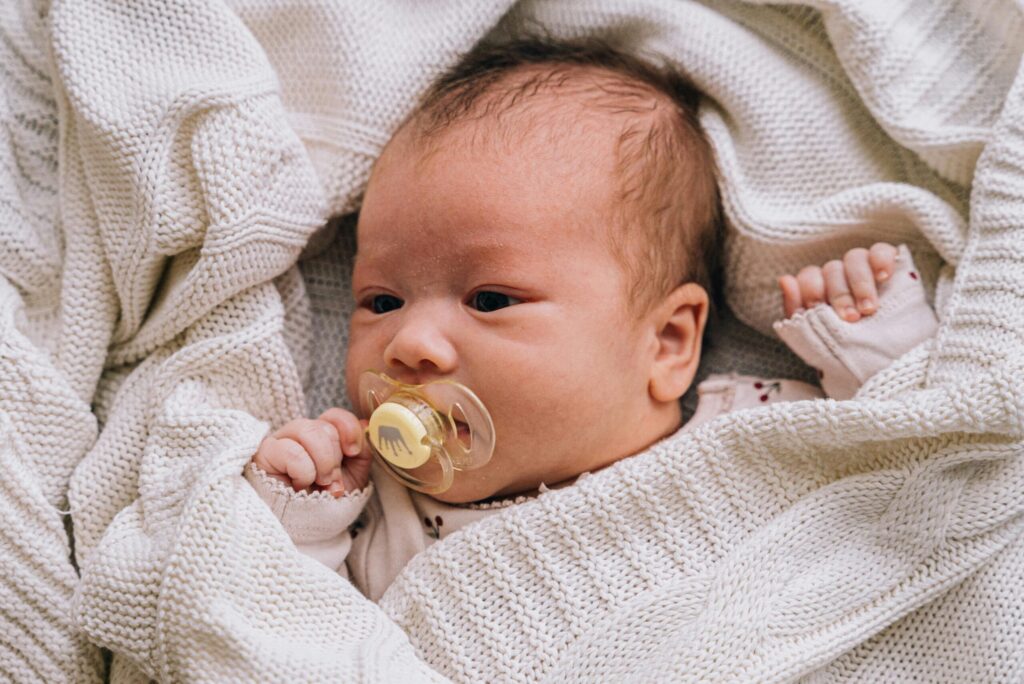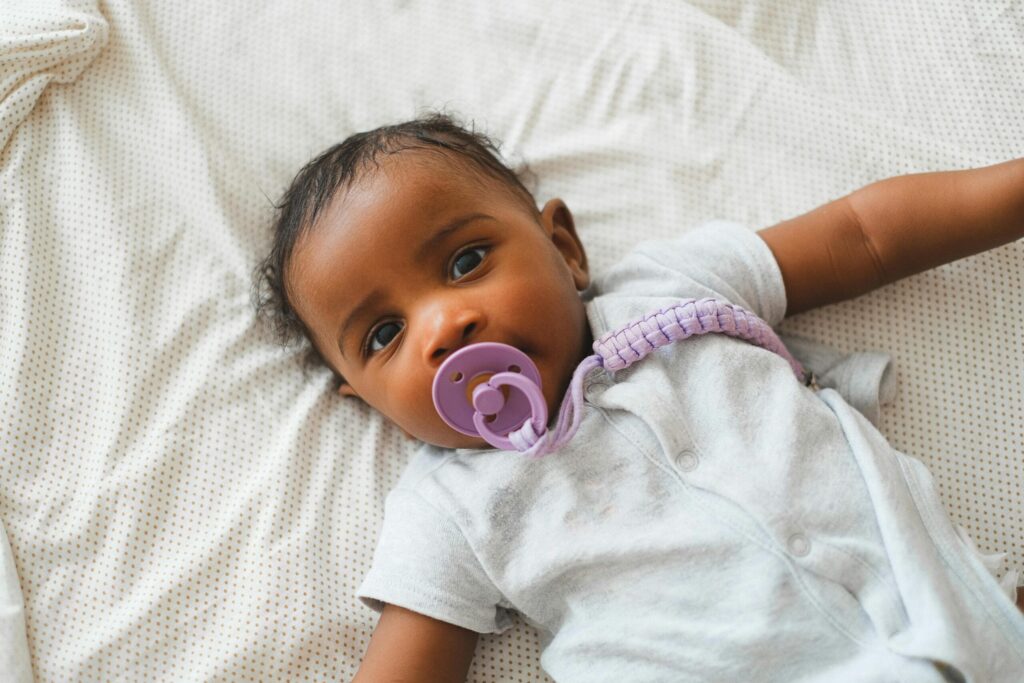As a mother of five and a midwife with over 20 years of experience, I’ve seen firsthand how the humble pacifier can be both a blessing and a challenge for parents. Let me share what I’ve learned about baby soothing solutions through my journey with my own children and the hundreds of families I’ve supported.
Understanding Baby Soothing Solutions
When my first little one arrived, I remember those long nights pacing the nursery floor, trying every trick in the book to calm those desperate cries. Like many new parents, I wondered if reaching for a pacifier was the right choice. Would it create bad habits? Would it interfere with breastfeeding? These questions are common, and the answers aren’t always straightforward.
Babies have a natural sucking reflex that extends beyond nutrition. This non-nutritive sucking helps them feel secure and comfortable. Many newborns will suck on their fingers or thumbs instinctively, showing just how deep this need runs. Baby soothing solutions like pacifiers can fulfill this natural urge while providing parents some much-needed relief.
The Science Behind Baby Soothing Solutions
Research published in the American Academy of Pediatrics journal suggests that non-nutritive sucking serves several developmental purposes. It helps babies regulate their emotions, provides comfort during stressful situations, and might even help them process sensory information. When we understand these benefits, choosing the right baby soothing solutions becomes less about convenience and more about supporting our little ones’ natural development.
The Benefits of Pacifiers
Over my years as both a midwife and mother, I’ve witnessed numerous advantages to thoughtful pacifier use. Let me share some of the most significant benefits I’ve observed.
Soothing Power for Fussy Moments
There’s something almost magical about how quickly a pacifier can transform a screaming infant into a content baby. When my third child was colicky, her pacifier was sometimes the only thing that would break the cycle of crying. For babies with a strong sucking need, pacifiers provide immediate comfort without always resorting to feeding, especially when hunger isn’t the issue.
Reduced SIDS Risk
One of the most compelling reasons I discuss baby soothing solutions with new parents is the connection between pacifier use during sleep and reduced risk of Sudden Infant Death Syndrome (SIDS). According to research from the National Institutes of Health, pacifier use during naps and bedtime can significantly decrease SIDS risk. As both a mother and healthcare provider, this benefit alone makes pacifiers worth considering.
Help With Difficult Procedures
In my midwifery practice, I’ve seen how pacifiers can be invaluable during necessary medical procedures. Whether it’s a blood draw, vaccination, or minor examination, offering a pacifier often provides comfort and distraction. This simple baby soothing solution can make healthcare experiences less traumatic for both babies and parents.
Short-Term Pain Relief
When my youngest was teething, her pacifier offered temporary relief from the discomfort. The pressure from sucking can help alleviate pain, making pacifiers helpful during teething, ear infections, or after vaccinations. Sometimes, these small comforts make all the difference in a baby’s day (and consequently, in parents’ sanity).
Potential Drawbacks to Consider
Despite their benefits, pacifiers aren’t without potential downsides. As I tell the families in my care, being informed about these possible issues helps you make thoughtful decisions about your baby soothing solutions.
Breastfeeding Considerations
When my first baby was born, I was advised to wait until breastfeeding was well-established before introducing a pacifier. This remains sound advice. Early pacifier introduction (before 3-4 weeks) can sometimes interfere with learning proper nursing techniques, especially for babies who are already having difficulty latching. However, once breastfeeding is going well, pacifiers rarely cause problems for most babies.
Dental Development Concerns
Long-term or excessive pacifier use can potentially affect dental development. I noticed with my second child that his persistent pacifier habit started to affect his front teeth alignment around age three. This is why timing the “pacifier retirement” is an important aspect of baby soothing solutions management.
Dependency and Sleep Association
Some babies become very attached to their pacifiers, creating challenges when they fall out during sleep. I remember countless nights retrieving and reinserting my daughter’s pacifier until we finally helped her learn to find and replace it herself. These sleep associations can temporarily disrupt sleep patterns for both babies and exhausted parents.
Ear Infection Risk in Some Children
Research suggests that in certain children, especially those already prone to ear infections, prolonged pacifier use might slightly increase the risk of middle ear infections. In my practice, I often recommend that parents of children with recurrent ear infections consider limiting pacifier use as one potential baby soothing solution adjustment.
Finding the Right Pacifier: Tips from My Experience

Not all pacifiers are created equal, and finding the right one can make all the difference. Through trial and error with my five children and counseling countless parents, I’ve learned that selecting appropriate baby soothing solutions requires attention to several factors.
Age-Appropriate Selection
Pacifiers come sized for different stages – newborn, 0-6 months, 6-18 months, and beyond. Using the wrong size can be ineffective or potentially unsafe. My youngest rejected every pacifier we tried until we realized we were offering one too large for her tiny mouth. The right size makes all the difference in acceptance and safety.
Construction and Safety Features
Look for one-piece pacifiers with a shield large enough that it can’t fit entirely in baby’s mouth. Air holes in the shield prevent skin irritation and allow for airflow. The sturdy construction was particularly important for my vigorous chewer, who could destroy lesser pacifiers in record time!
Material Considerations
Silicone pacifiers tend to be easier to clean and more durable, while natural rubber or latex options are softer but wear out faster. My first three children preferred silicone, but my fourth would only accept natural rubber pacifiers. Every baby has preferences, so don’t be discouraged if you need to try several types before finding the perfect baby soothing solution for your little one.
Best Practices for Pacifier Use
Implementing thoughtful routines around pacifier use can maximize benefits while minimizing potential problems. These practical tips have served me well across two decades of midwifery and five children of my own.
Timing the Introduction
If you’re breastfeeding, consider waiting until nursing is well-established (typically 3-4 weeks) before introducing a pacifier. With my first baby, I was anxious to try any baby soothing solution available, but waiting until our nursing relationship was solid made for smoother sailing overall.
Cleaning and Maintenance
Maintaining clean pacifiers is essential, especially for newborns. I keep a rotation system with at least 4-5 pacifiers, so there’s always a clean one available. Dishwasher cleaning (in a closed basket) or boiling for 5 minutes works well for deep cleaning, while a quick rinse under hot water handles immediate needs when you’re out and about.
When to Offer the Pacifier
Learning when to offer the pacifier and when to try other baby soothing solutions takes practice. I advise parents to first check if hunger, discomfort, or dirty diapers might be causing fussiness before reaching for the pacifier. Using it as one tool in your comfort toolkit rather than the only response to crying helps maintain balance.
Limiting Use as Baby Grows
As babies develop, gradually restricting pacifier use to sleep times helps reduce dependency while still supporting good sleep habits. With my children, we implemented a “pacifiers are for sleeping” rule around 6-8 months, keeping these baby soothing solutions special rather than constant companions.
The Pacifier Farewell: When and How
All good things must come to an end, including the pacifier relationship. In my experience, timing this transition thoughtfully makes it much less traumatic for everyone involved.
Ideal Timing for Weaning
From both my professional and personal experience, the ideal window for pacifier retirement typically falls between 2-4 years. Earlier tends to be easier, but every child is different. My oldest gave hers up easily at 18 months, while my third needed gentle encouragement well into his third year.
Gentle Approaches to Pacifier Retirement
When it’s time to say goodbye to the pacifier, gradual approaches usually work better than cold turkey. With my children, we tried various baby soothing solutions for retirement – trading pacifiers for a special toy, having the “pacifier fairy” visit, or progressively cutting the tips to make them less satisfying. The key is choosing a method that matches your child’s personality and readiness.
Handling Regression During Stress
Sometimes during illness, major life changes, or stress, children who’ve given up pacifiers want them back. This happened when we moved houses with my second child. In these cases, temporary regression to familiar baby soothing solutions might be appropriate, with gentle guidance back to pacifier-free life once the stressful period passes.
Trust Your Parental Instincts
After five children and thousands of families in my midwifery practice, I’ve learned that there’s no one-size-fits-all answer to the pacifier question. What works beautifully for one family might be completely wrong for another.
Your understanding of your unique baby, family dynamics, and parenting philosophy should guide your decisions about baby soothing solutions. Notice what brings your baby comfort, be willing to adjust your approach as needed, and remember that responsive parenting matters more than any specific tool or technique.
The humble pacifier, like so many aspects of parenting, isn’t inherently good or bad – it’s simply one option in your caregiving toolkit. Armed with solid information and tuned into your baby’s needs, you’ll find the right balance for your precious little one.
Remember, this journey of parenthood is brief, even when the nights feel endless. The pacifier debates will be distant memories before you know it, replaced by new parenting adventures. Trust yourself, love abundantly, and take each day as it comes.



